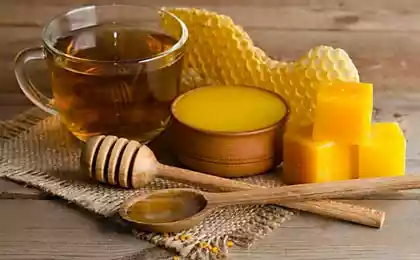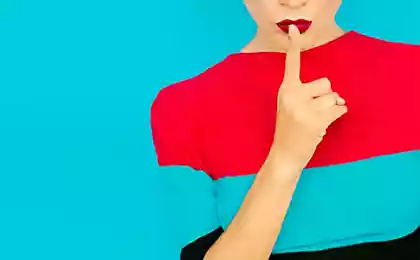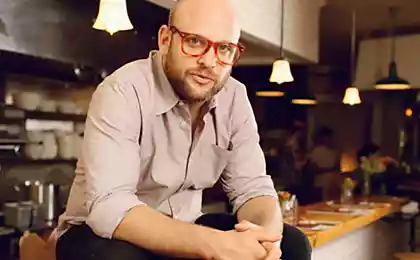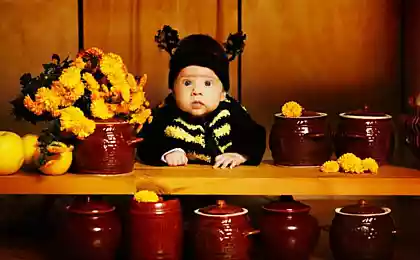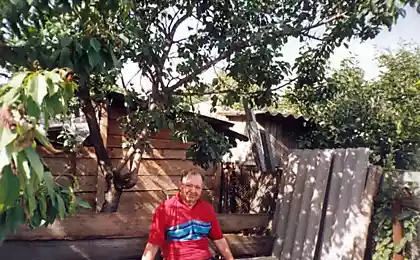623
What is the correct med
It is remarkable how many prejudices and misconceptions about honey and other bee products. For example, I as a beekeeper, was under the table with laughter when I heard in a documentary of National Geographic about insects that bees collect pollen from flowers and turn it into honey. This statement is equivalent to saying that sugar is made from meat!
I will try to clarify the true state of Affairs in some of these cases.
Flower honey
Natural honey can be floral and honeydew. Flower honey is made by bees from the nectar of flowering plants. Bees collect nectar consisting of water (50 to 80%) and sugars (up to 25% monosaccharides and up to 25% of complex sugars mainly sucrose), treated it with enzymes maxillary glands and evaporated from it of excess water. Under the action of enzymes, complex sugars are broken down into monosaccharides, also changes the acidity of the honey. This process is called maturation of honey.
Twenty million four hundred ninety nine thousand one hundred seventy six
The main components of honey: glucose and fructose are monosaccharides that make up 80% of the mass of honey and are absorbed directly in the digestive tract starting from the oral cavity because it does not require previous treatment of digestive juices. On average, honey contains fructose — 38-44 %, glucose — 31-36 % and water — 17-21 %, energy value 3150-3350 kcal, which is lower than the energy value of sugar (sucrose) is 4000 kcal. But it is more sweet than beet sugar due to the fructose which is 1.7 times sweeter than sucrose. The composition of honey include: sodium, potassium, magnesium, iron, chlorine, phosphorus, sulfur, iodine,…
Generating interest and importance that the amount of some mineral salts in the composition of honey is almost the same as in the serum of human blood (!). There are med and low molecular weight biologically active ingredients (vitamins, amino acids, and the like). Although they are few, but they are of great importance. When used they contribute to the normalization of the digestive tract, are absorbed quickly, provide vital organs and tissues valuable energy and plastic compounds. Is honey and stimulants that enhance the functioning of the organism, enzymes, macro - and micronutrients, hydrogen peroxide, herbal antibiotics, lysozyme, acetylcholine and other substances.
Honeydew honey: helpful or harmful?
Honeydew honey is produced by bees not from the nectar, but from honeydew, the sweet secretions of insects such as aphids, mealybugs and psyllids, as well as from honeydew (there are plants that in extreme heat, like some potted flowers isolated on leaves and/or stems of the droplets of sweet juice). Honeydew honey contains in comparison with flower a lot more minerals and residual polysaccharides.
Here we meet with the first misconception: honeydew honey harmful and/or poisonous. That's not entirely true, even absolutely true! Poisonous or toxic honey depends on the plant species, which was collected nectar or honeydew. For example, from the nectar of rhododendron (Azalea) blooming beautiful spring yellow flowers green plants, contains a very potent alkaloids.
Similarly, the pad with belladonna or Datura will be to some extent toxic. From this honey glazik on the forehead climb. On the other hand well-known researchers of bee products, such as N. Joris and S. Mladenov in their clinical research of the therapeutic properties of honey have found that some varieties of honeydew honeys due to its high content of mineral elements and other biologically active substances are superior in therapeutic effect, many varieties of flower honey!
Liquid or crystallized honey
Surprisingly there is a lot of prejudice around that, what should be the honey, liquid or secretaryoffice. Honey can be liquid, thick and crystallized. Liquid honey is, as a rule, summer (July — August) during its pumping. After 1 – 2 months he kristallizuetsya. Moreover, the tendency to crystallization from different varieties of honey varies. And it depends, first, on the ratio of glucose and fructose in honey. The larger percentage of glucose, the faster honey kristallizuetsya.
Second, the percentage content of sugar such as melezitose that falls small white savoury to the taste with crystals, which serve as centers of crystallization.
Third, the crystallization of the faster, the more honey gets the pollen grains.
Fourth, the percentage of minerals: the more, the faster the honey thickens. Complex sugars, particularly dextrins, on the contrary reduce the ability of honey to crystallize. The rate of crystallization also depends on the temperature: warm honey kristallizuetsya slower and the crystals get smaller. Sometimes honey kristallizuetsya evenly, but sometimes, especially when he was abruptly cooled, for example, moved into the cellar, into: glucose drops with crystals, and the solution of fructose remains liquid. And it is normal for natural honey, often it happens with buckwheat.
Here it should be noted that to prevent crystallization of honey can be pasteurization, i.e. heating up to 57-63°C for 10-25 minutes. After this treatment, the honey remains liquid for a long time, but its biological activity is sharply reduced. So if the winter or spring sold liquid honey, it is likely that he or pasteurized or adulterated. The exception is the honey from white acacia that long kristallizuetsya, and Heather, turns into a gelatinous mass. Canola honey during crystallization acquires a consistency resembling lard (melted pig fat).
May honey
I, as a beekeeper, it's funny to see how people create a hype around some of the "may honey". Judge for yourself: the honey is buckwheat, lime, grass and, suddenly, "may." And why not June or August? After all, you don't think that this cunning "may" honey bees collect from the leaf of the calendar! This at best can mean that the honey is pumped out at the end of spring, and spring honey Oh how different! After all, from late March to may bloom so much, and every district is different. And bees, by the way, I fly for nectar in a radius of up to 4.5 km, and generally productive of honey is considered the radius of 2,5-3 km away. it turns out that one spring apiary honey can be with orchards, and on the other with forest trees and dandelion. And the myth of the "may honey", as for me, just mass delusion that is supported with commercial interest because this honey can be expensive "to sell".
Honey should be stored in the shade!
But no one in the Bazaar never, never gonna tell you that honey should not be exposed to sunlight! Meanwhile, this is perhaps the most important point: even diffused sunlight for 4-6 hours destroys almost all the enzymes and biologically active substances of honey. And the direct rays of the sun in just 10-15 minutes reduce to zero the super-biological activity and utility of honey, which should be valued. And you buy a nice thick syrup monosaccharides, which, of course, sugar is better, but not what you wanted. Therefore, it is important to store honey! Swing your honey needs in artificial lighting without ultraviolet radiation and to save in the dark. Even on the table it should be served in an opaque container with a lid.
Honey for the treatment
For the treatment of honey you should choose very carefully, because harvested from the various plants he has differing therapeutic properties. For example, acacia honey is sedative, and brown – a great antiseptic, promotes good blood circulation, beneficial effect on the liver and the prostate gland.
Rapeseed honey gives high therapeutic effect on varicose ulcers, dandelion replaces diuretic and laxatives.
Sage honey effective for gastro-intestinal diseases, helps to regulate the menstrual cycle, and has a diaphoretic action.
Lime honey it is recommended for colds, bronchial asthma, inflammation of the gastrointestinal tract. Honey from acacia (Japanese) strengthens capillary blood vessels and increases blood clotting. Apple beneficial effect on the heart muscle.
Minty has choleretic, sedative, analgesic effect. Although in fairness it should be clarified that pure monofloral, that is collected by bees from one kind of plant, honey happens is that somewhere in Arizona on the orange plantations, except where orange trees in all corners of the horizon do not bloom. Nature is so provided to ensure the health of bees is that they always try to diversify the species composition of honey. And always about 20% of honey is from some alternative sources, even if the apiary is in the middle of the array honey plants, for example, fields of buckwheat. Because when we call the variety of honey on some plant, we mean that the honey nectar of this plant is more than 50%. And in Arizona, by the way, the bees so they don't hurt, feed vitamin supplements.
How to distinguish natural honey
Everyone is always interested in the question of how to determine the naturalness of the honey and to calculate a fake. Well, first, there are many ways fraud and, accordingly, many methods to test honey on a particular method of falsification. To all interested I recommend to read about it in the book of Stojmir Mladenov "Honey and medolechenie".
And I all these ways I will not describe here why: the cheapest, easiest to perform and widespread way of rigging is to feed the bees sugar syrup. They will process it just like nectar is processed, it seems to be honey, but not the same: in this counterfeit does not have the BAS and minerals that make honey the healing. In addition, there is in academia is an opinion, however controversial, that the monosaccharides of the honey, as does white sugar have the spin of the electron (roughly speaking, the electron revolves in the opposite direction) opposite to the sugars of nectar, fruit, berries and honey. What makes white sugar "inedible" at the subcellular level, because he is "white death".
But to determine such adulteration is possible only in a major laboratory, any organoleptic (appearance, taste and smell) ways it can be done.
So the answer to the question of how to buy guaranteed quality bee products one: you have to buy them from this beekeeper, who can be trusted. That is, quite simply, it all depends on the decency and morals of the beekeeper: there are many points in the technological processes of beekeeping, where to fake easier and cheaper than to do the right thing.
How to use honey
Can be different. There are different opinions whether to add honey to hot tea. Of course, at a high temperature of tea properties are lost. For example, I eat honey vprikusku with tea, Goltis said that it is annoying, and he puts honey in tea — this is not fatal, there is already everyone decides as he sees fit. Most fully and quickly absorbed the honey dissolved in water or tea at room temperature.
The benefits of pollen
More useful than pollen, mixed with honey? Here there are two pitfalls. First, honey, you can mix dried pollen and fresh. Here it is necessary to clarify that pollen in the form in which it familiar to the buyer (something like colored grains) is dried bee pollen. Bees collecting pollen, moisten it with nectar and put them in clumps on their hind legs. Cunning beekeepers thought of such a thing:
Seventy four million four hundred forty eight thousand eight hundred seven
When bees "schimyatsya" home through these small holes, part of the pollen with the hind legs clinging to the edges and falls through a latticed box. This pollen has a high humidity and rubs between his fingers like damp powdered sugar. As such, it does not keep long, so it dried. But in this fresh form, it has all its 100% activity-utility.
We for long-term storage for myself always prefer to mix honey with fresh pollen. It's a double win. First, the honey eliminates oxidation of pollen by air oxygen, and thus prolongs the preservation of its usefulness. And, secondly, facilitates the digestion of pollen by the body.
The fact that each pollen grain is a microscopic capsule that encloses two cells, just the same "napisannye" highly concentrated biologically active substances, vitamins, amino acids and trace elements. This capsule is similar to something like a round basket woven of cellulose, with all the holes in this basket as if smeared with starch. Cellulose, it is known that the human body does not digest, and the capsule itself is so small that we can't get it to crack. All the digestion of pollen is the degradation amiloliticescoe saliva enzyme starch "corks" and diffuse the suction of the contents of the pollen grain. That's why Goltis directs it to dissolve the pollen.
When mixed with honey the decomposition of starch in pollen begins to occur immediately in the mix at the expense of amiloliticescoe enzyme honey diastase. And BAS pollen moving in the fluid.
It should also be noted that different varieties of honey contain different amounts of diastase: most in buckwheat and least in acacia. Therefore, the choice of type of honey for the preservation of pollen is not the last value.
Bee products
Here are just a small part of what can be said about the bee products. But apart from the honey and pollen have more propolis, bee Podmore available drone homogenate, wax moth and, of course, Royal jelly. It has been experimentally proven that a person can indefinitely to only eat bee products and they will be more than to provide all the needs even during ultra-intense physical exertion.
I myself twice in the spring and summer spent 2 and 1 month, eating only honey, pollen and berries. Before the start of classes AI it was periods best health of my life. After attending the workshop, I started an experiment on myself for a major share in the food are the foods from our apiary. I'm sure the results will be great. I sincerely wish every practicing iechnical perseverance and tenacity to learn this wonderful technique! published
P. S. And remember, only by changing their consumption — together we change the world! © Join us at Facebook , Vkontakte, Odnoklassniki
Source: goltisacademy.com/articles/vechnyj-vopros-vinni-puxa-kakoj-med-pravilnyj/
I will try to clarify the true state of Affairs in some of these cases.
Flower honey
Natural honey can be floral and honeydew. Flower honey is made by bees from the nectar of flowering plants. Bees collect nectar consisting of water (50 to 80%) and sugars (up to 25% monosaccharides and up to 25% of complex sugars mainly sucrose), treated it with enzymes maxillary glands and evaporated from it of excess water. Under the action of enzymes, complex sugars are broken down into monosaccharides, also changes the acidity of the honey. This process is called maturation of honey.
Twenty million four hundred ninety nine thousand one hundred seventy six
The main components of honey: glucose and fructose are monosaccharides that make up 80% of the mass of honey and are absorbed directly in the digestive tract starting from the oral cavity because it does not require previous treatment of digestive juices. On average, honey contains fructose — 38-44 %, glucose — 31-36 % and water — 17-21 %, energy value 3150-3350 kcal, which is lower than the energy value of sugar (sucrose) is 4000 kcal. But it is more sweet than beet sugar due to the fructose which is 1.7 times sweeter than sucrose. The composition of honey include: sodium, potassium, magnesium, iron, chlorine, phosphorus, sulfur, iodine,…
Generating interest and importance that the amount of some mineral salts in the composition of honey is almost the same as in the serum of human blood (!). There are med and low molecular weight biologically active ingredients (vitamins, amino acids, and the like). Although they are few, but they are of great importance. When used they contribute to the normalization of the digestive tract, are absorbed quickly, provide vital organs and tissues valuable energy and plastic compounds. Is honey and stimulants that enhance the functioning of the organism, enzymes, macro - and micronutrients, hydrogen peroxide, herbal antibiotics, lysozyme, acetylcholine and other substances.
Honeydew honey: helpful or harmful?
Honeydew honey is produced by bees not from the nectar, but from honeydew, the sweet secretions of insects such as aphids, mealybugs and psyllids, as well as from honeydew (there are plants that in extreme heat, like some potted flowers isolated on leaves and/or stems of the droplets of sweet juice). Honeydew honey contains in comparison with flower a lot more minerals and residual polysaccharides.
Here we meet with the first misconception: honeydew honey harmful and/or poisonous. That's not entirely true, even absolutely true! Poisonous or toxic honey depends on the plant species, which was collected nectar or honeydew. For example, from the nectar of rhododendron (Azalea) blooming beautiful spring yellow flowers green plants, contains a very potent alkaloids.
Similarly, the pad with belladonna or Datura will be to some extent toxic. From this honey glazik on the forehead climb. On the other hand well-known researchers of bee products, such as N. Joris and S. Mladenov in their clinical research of the therapeutic properties of honey have found that some varieties of honeydew honeys due to its high content of mineral elements and other biologically active substances are superior in therapeutic effect, many varieties of flower honey!
Liquid or crystallized honey
Surprisingly there is a lot of prejudice around that, what should be the honey, liquid or secretaryoffice. Honey can be liquid, thick and crystallized. Liquid honey is, as a rule, summer (July — August) during its pumping. After 1 – 2 months he kristallizuetsya. Moreover, the tendency to crystallization from different varieties of honey varies. And it depends, first, on the ratio of glucose and fructose in honey. The larger percentage of glucose, the faster honey kristallizuetsya.
Second, the percentage content of sugar such as melezitose that falls small white savoury to the taste with crystals, which serve as centers of crystallization.
Third, the crystallization of the faster, the more honey gets the pollen grains.
Fourth, the percentage of minerals: the more, the faster the honey thickens. Complex sugars, particularly dextrins, on the contrary reduce the ability of honey to crystallize. The rate of crystallization also depends on the temperature: warm honey kristallizuetsya slower and the crystals get smaller. Sometimes honey kristallizuetsya evenly, but sometimes, especially when he was abruptly cooled, for example, moved into the cellar, into: glucose drops with crystals, and the solution of fructose remains liquid. And it is normal for natural honey, often it happens with buckwheat.
Here it should be noted that to prevent crystallization of honey can be pasteurization, i.e. heating up to 57-63°C for 10-25 minutes. After this treatment, the honey remains liquid for a long time, but its biological activity is sharply reduced. So if the winter or spring sold liquid honey, it is likely that he or pasteurized or adulterated. The exception is the honey from white acacia that long kristallizuetsya, and Heather, turns into a gelatinous mass. Canola honey during crystallization acquires a consistency resembling lard (melted pig fat).
May honey
I, as a beekeeper, it's funny to see how people create a hype around some of the "may honey". Judge for yourself: the honey is buckwheat, lime, grass and, suddenly, "may." And why not June or August? After all, you don't think that this cunning "may" honey bees collect from the leaf of the calendar! This at best can mean that the honey is pumped out at the end of spring, and spring honey Oh how different! After all, from late March to may bloom so much, and every district is different. And bees, by the way, I fly for nectar in a radius of up to 4.5 km, and generally productive of honey is considered the radius of 2,5-3 km away. it turns out that one spring apiary honey can be with orchards, and on the other with forest trees and dandelion. And the myth of the "may honey", as for me, just mass delusion that is supported with commercial interest because this honey can be expensive "to sell".
Honey should be stored in the shade!
But no one in the Bazaar never, never gonna tell you that honey should not be exposed to sunlight! Meanwhile, this is perhaps the most important point: even diffused sunlight for 4-6 hours destroys almost all the enzymes and biologically active substances of honey. And the direct rays of the sun in just 10-15 minutes reduce to zero the super-biological activity and utility of honey, which should be valued. And you buy a nice thick syrup monosaccharides, which, of course, sugar is better, but not what you wanted. Therefore, it is important to store honey! Swing your honey needs in artificial lighting without ultraviolet radiation and to save in the dark. Even on the table it should be served in an opaque container with a lid.
Honey for the treatment
For the treatment of honey you should choose very carefully, because harvested from the various plants he has differing therapeutic properties. For example, acacia honey is sedative, and brown – a great antiseptic, promotes good blood circulation, beneficial effect on the liver and the prostate gland.
Rapeseed honey gives high therapeutic effect on varicose ulcers, dandelion replaces diuretic and laxatives.
Sage honey effective for gastro-intestinal diseases, helps to regulate the menstrual cycle, and has a diaphoretic action.
Lime honey it is recommended for colds, bronchial asthma, inflammation of the gastrointestinal tract. Honey from acacia (Japanese) strengthens capillary blood vessels and increases blood clotting. Apple beneficial effect on the heart muscle.
Minty has choleretic, sedative, analgesic effect. Although in fairness it should be clarified that pure monofloral, that is collected by bees from one kind of plant, honey happens is that somewhere in Arizona on the orange plantations, except where orange trees in all corners of the horizon do not bloom. Nature is so provided to ensure the health of bees is that they always try to diversify the species composition of honey. And always about 20% of honey is from some alternative sources, even if the apiary is in the middle of the array honey plants, for example, fields of buckwheat. Because when we call the variety of honey on some plant, we mean that the honey nectar of this plant is more than 50%. And in Arizona, by the way, the bees so they don't hurt, feed vitamin supplements.
How to distinguish natural honey
Everyone is always interested in the question of how to determine the naturalness of the honey and to calculate a fake. Well, first, there are many ways fraud and, accordingly, many methods to test honey on a particular method of falsification. To all interested I recommend to read about it in the book of Stojmir Mladenov "Honey and medolechenie".
And I all these ways I will not describe here why: the cheapest, easiest to perform and widespread way of rigging is to feed the bees sugar syrup. They will process it just like nectar is processed, it seems to be honey, but not the same: in this counterfeit does not have the BAS and minerals that make honey the healing. In addition, there is in academia is an opinion, however controversial, that the monosaccharides of the honey, as does white sugar have the spin of the electron (roughly speaking, the electron revolves in the opposite direction) opposite to the sugars of nectar, fruit, berries and honey. What makes white sugar "inedible" at the subcellular level, because he is "white death".
But to determine such adulteration is possible only in a major laboratory, any organoleptic (appearance, taste and smell) ways it can be done.
So the answer to the question of how to buy guaranteed quality bee products one: you have to buy them from this beekeeper, who can be trusted. That is, quite simply, it all depends on the decency and morals of the beekeeper: there are many points in the technological processes of beekeeping, where to fake easier and cheaper than to do the right thing.
How to use honey
Can be different. There are different opinions whether to add honey to hot tea. Of course, at a high temperature of tea properties are lost. For example, I eat honey vprikusku with tea, Goltis said that it is annoying, and he puts honey in tea — this is not fatal, there is already everyone decides as he sees fit. Most fully and quickly absorbed the honey dissolved in water or tea at room temperature.
The benefits of pollen
More useful than pollen, mixed with honey? Here there are two pitfalls. First, honey, you can mix dried pollen and fresh. Here it is necessary to clarify that pollen in the form in which it familiar to the buyer (something like colored grains) is dried bee pollen. Bees collecting pollen, moisten it with nectar and put them in clumps on their hind legs. Cunning beekeepers thought of such a thing:
Seventy four million four hundred forty eight thousand eight hundred seven
When bees "schimyatsya" home through these small holes, part of the pollen with the hind legs clinging to the edges and falls through a latticed box. This pollen has a high humidity and rubs between his fingers like damp powdered sugar. As such, it does not keep long, so it dried. But in this fresh form, it has all its 100% activity-utility.
We for long-term storage for myself always prefer to mix honey with fresh pollen. It's a double win. First, the honey eliminates oxidation of pollen by air oxygen, and thus prolongs the preservation of its usefulness. And, secondly, facilitates the digestion of pollen by the body.
The fact that each pollen grain is a microscopic capsule that encloses two cells, just the same "napisannye" highly concentrated biologically active substances, vitamins, amino acids and trace elements. This capsule is similar to something like a round basket woven of cellulose, with all the holes in this basket as if smeared with starch. Cellulose, it is known that the human body does not digest, and the capsule itself is so small that we can't get it to crack. All the digestion of pollen is the degradation amiloliticescoe saliva enzyme starch "corks" and diffuse the suction of the contents of the pollen grain. That's why Goltis directs it to dissolve the pollen.
When mixed with honey the decomposition of starch in pollen begins to occur immediately in the mix at the expense of amiloliticescoe enzyme honey diastase. And BAS pollen moving in the fluid.
It should also be noted that different varieties of honey contain different amounts of diastase: most in buckwheat and least in acacia. Therefore, the choice of type of honey for the preservation of pollen is not the last value.
Bee products
Here are just a small part of what can be said about the bee products. But apart from the honey and pollen have more propolis, bee Podmore available drone homogenate, wax moth and, of course, Royal jelly. It has been experimentally proven that a person can indefinitely to only eat bee products and they will be more than to provide all the needs even during ultra-intense physical exertion.
I myself twice in the spring and summer spent 2 and 1 month, eating only honey, pollen and berries. Before the start of classes AI it was periods best health of my life. After attending the workshop, I started an experiment on myself for a major share in the food are the foods from our apiary. I'm sure the results will be great. I sincerely wish every practicing iechnical perseverance and tenacity to learn this wonderful technique! published
P. S. And remember, only by changing their consumption — together we change the world! © Join us at Facebook , Vkontakte, Odnoklassniki
Source: goltisacademy.com/articles/vechnyj-vopros-vinni-puxa-kakoj-med-pravilnyj/
Wood in interior decoration: creative and stylish!
Useful smoothies for hypertension; 4 delicious recipes





